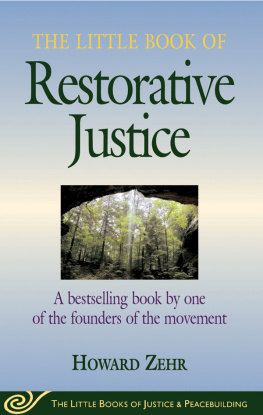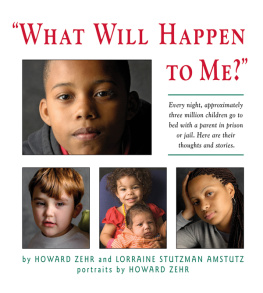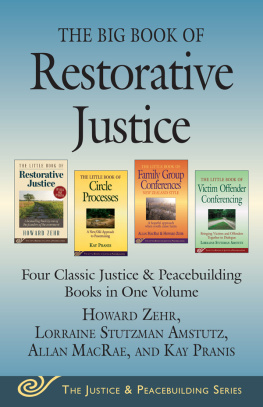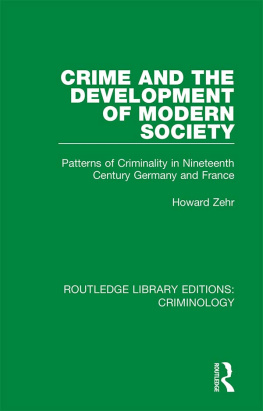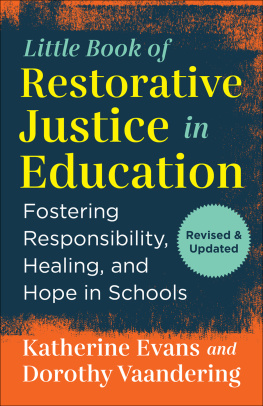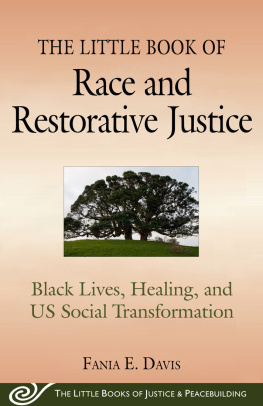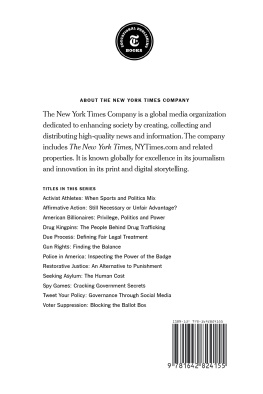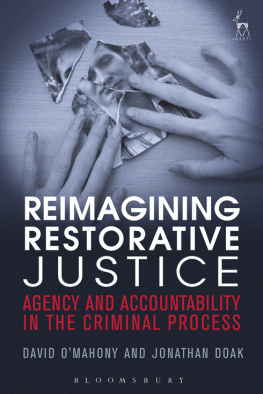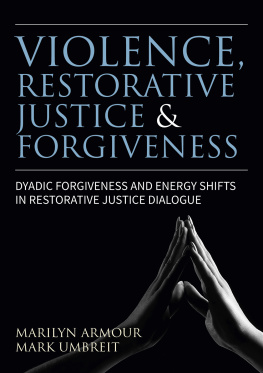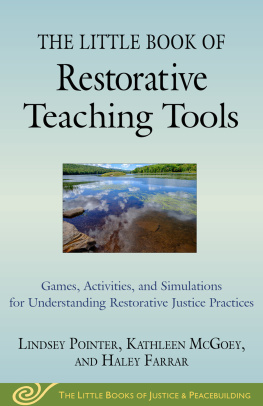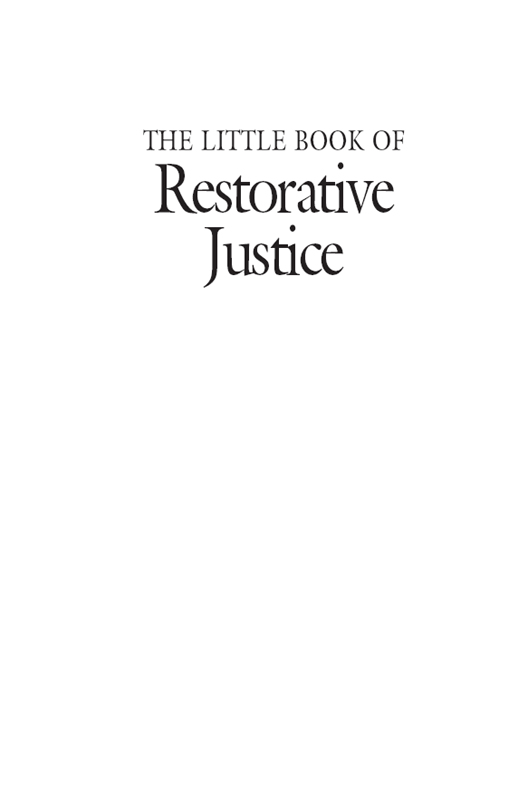
Published titles include:
The Little Book of Restorative Justice, by Howard Zehr
The Little Book of Conflict Transformation, by John Paul Lederach
The Little Book of Family Group Conferences, New-Zealand Style, by Allan MacRae and Howard Zehr
The Little Book of Strategic Peacebuilding, by Lisa Schirch
The Little Book of Strategic Negotiation, by Jayne Seminare Docherty
The Little Book of Circle Processes, by Kay Pranis
The Little Book of Contemplative Photography, by Howard Zehr
Forthcoming titles or topics include:
The Little Book of Restorative Discipline for Schools, by Lorraine Stutzman Amstutz and Judy H. Mullet
The Little Book of Trauma Healing, by Carolyn Yoder
The Little Book of Biblical Justice, by Chris Marshall
El Pequeo Libro De Justicia Restaurativa, by Howard Zehr
The Little Books of Justice & Peacebuilding
present, in highly accessible form, key concepts and practices from the fields of restorative justice, conflict transformation, and peacebuilding. Written by leaders in these fields, they are designed for practitioners, students, and anyone interested in justice, peace, and conflict resolution.
The Little Books of Justice & Peacebuilding
series is a cooperative effort between the Center for Justice and Peacebuilding of Eastern Mennonite University (Howard Zehr, Series General Editor) and publisher Good Books (Phyllis Pellman Good, Senior Editor).
Acknowledgments
A special thanks to the many friends and colleagues who gave me feedback on this manuscript. This includes my students, former students, and colleagues at the Conflict Transformation Program where I teach. I especially want to thank Barb Toews Shenk, Jarem Sawatsky, Bonnie Price Lofton, Robert Gillette, Vernon Jantzi, Larissa Fast, and Ali Gohar for their careful attention and suggestions. Although the suggestions were not always easy to hear, and I was not able to incorporate all, the book is much better because of them.
Copyright 2014 by Howard Zehr
All rights reserved. No part of this book may be reproduced in any manner without the express written consent of the publisher, except in the case of brief excerpts in critical reviews or articles. All inquiries should be addressed to Good Books, 307 West 36th Street, 11th Floor, New York, NY 10018.
Good Books books may be purchased in bulk at special discounts for sales promotion, corporate gifts, fund-raising, or educational purposes. Special editions can also be created to specifications. For details, contact the Special Sales Department, Good Books, 307 West 36th Street, 11th Floor, New York, NY 10018 or info@skyhorsepublishing.com.
Good Books in an imprint of Skyhorse Publishing, Inc., a Delaware corporation.
Visit our website at www.goodbooks.com.
10 9 8 7 6 5 4 3 2 1
Library of Congress Cataloging-in-Publication Data is available on file.
Cover photograph by Howard Zehr
Design by Dawn J. Ranck
Print ISBN: 978-1-56148-376-1
Ebook ISBN: 978-1-68099-044-7
Printed in the United States of America
Library of Congress Cataloging-in-Publication Data
Zehr, Howard
The little book of restorative justice / Howard Zehr.
p.cm.
Includes bibliographical references.
ISBN 1-56148-376-1; 978-1-56148-376-1
1. Restorative justice. 2. Victims of crimes. 3. CriminalsRehabilitation. 4. CorrectionsPhilosophy. 5. Criminal justice, Administration of. I. Title: Restorative justice. II. Title.
HV8688.Z44 2002
Table of Contents
1.
An Overview
H ow should we as a society respond to wrongdoing? When a crime occurs or an injustice is done, what needs to happen? What does justice require?
For North Americans, the urgency of these questions has been intensified by the traumatic events of September 11, 2001. The debate is an old one, though, and is truly international in scope.
Whether we are concerned with crime or other offenses, the Western legal system has profoundly shaped our thinking about these issuesnot only in the Western world, but in much of the rest of the world as well.
The Western legal, or criminal justice, systems approach to justice has some important strengths. Yet there is also a growing acknowledgment of this systems limits and failures. Victims, offenders, and community members often feel that justice does not adequately meet their needs. Justice professionalsjudges, lawyers, prosecutors, probation and parole officers, prison stafffrequently express a sense of frustration as well. Many feel that the process of justice deepens societal wounds and conflicts rather than contributing to healing or peace.
Restorative justice is an attempt to address some of these needs and limitations. Since the 1970s, a variety of programs and approaches have emerged in thousands of communities and many countries throughout the world. Often these are offered as choices within or alongside the existing legal system. Starting in 1989, however, New Zealand has made restorative justice the hub of its entire juvenile justice system.
In many places today, restorative justice is considered a sign of hope and the direction of the future. Whether it will live up to this promise remains to be seen.
Restorative justice began as an effort to deal with burglary and other property crimes that are usually viewed (often incorrectly) as relatively minor offenses. Today, however, restorative approaches are available in some communities for the most severe forms of criminal violence: death from drunken driving, assault, rape, even murder. Building upon the experience of the Truth and Reconciliation Commission in South Africa, efforts are also being made to apply a restorative justice framework to situations of mass violence.
These approaches and practices are also spreading beyond the criminal justice system to schools, to the workplace, and to religious institutions. Some advocate the use of restorative approaches such as circles (a particular practice that emerged from First Nation communities in Canada) as a way to work through, resolve, and transform conflicts in general. Others pursue circles or conferences (an effort with roots both in New Zealand and Australia, and in facilitated victim-offender meetings) as a way to build and heal communities. Kay Pranis, a prominent restorative justice advocate, calls circles a form of participatory democracy that moves beyond simple majority rule (see for a fuller explanation of circles as understood in the restorative justice field).
In societies where Western legal systems have replaced and/or suppressed traditional justice and conflict-resolution processes, restorative justice is providing a framework to reexamine and sometimes reactivate these traditions.
Although the term restorative justice encompasses a variety of programs and practices, at its core it is a set of principles, a philosophy, an alternate set of guiding questions. Ultimately, restorative justice provides an alternative framework for thinking about wrongdoing. I will explore that framework in the pages that follow, and look at how it could be put to use.
Why this Little Book ?
In this Little Book , I do not try to make the case for restorative justice. Nor do I explore the many implications of this approach. Rather, I intend this book to be a brief description or overviewthe CliffsNotes , if you will, of restorative justice. Although I will outline some of the programs and practices of restorative justice, my focus in this book is especially the principles or philosophy of restorative justice.

